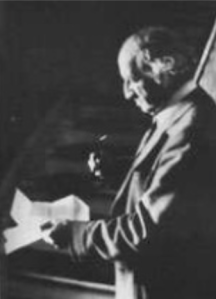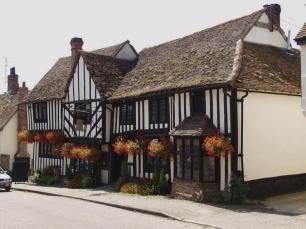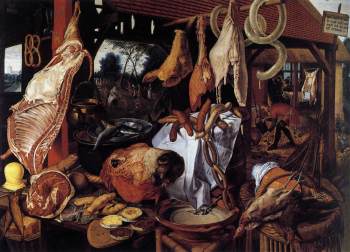Looking back, the really strange thing was the silence. The way the church bells stopped ringing as the little group of naval cadets neared the village. The way even the ducks stood quiet and motionless by the shallow stream that ran across the road where the main street began.
And, when the boys thought about it afterward, they recalled that even the autumn birdsong faded as they neared the first houses. The wind had dropped to nothing, too.
Not a leaf stirred on the trees they passed. And the trees appeared to cast no shadows.
The street itself was quite deserted—not so odd, perhaps, for a Sunday morning in 1957, especially in the rural heart of England. But even the remotest British hamlets displayed some signs of modernity by then—cars parked by the roadside, phone wires strung along the roads, aerials on roofs—and there was nothing of that sort in this village. In fact, the houses on the high street all looked ancient; they were ragged, hand-built, timber-framed: “almost medieval in appearance,” one boy thought.
The three, all Royal Navy cadets, walked up to the nearest building and pressed their faces to its grimy windows. They could see that it was some sort of butcher’s shop, but what they glimpsed in the interior was even more unsettling. As one of them recalled for the author Andrew MacKenzie:
There were no tables or counters, just two or three whole oxen carcasses which had been skinned and in places were quite green with age. There was a green-painted door and windows with smallish glass panes, one at the front and one at the side, rather dirty-looking. I remember that as we three looked through that window in disbelief at the green and mouldy green carcasses… the general feeling certainly was one of disbelief and unreality… Who would believe that in 1957 that the health authorities would allow such conditions?
They peered into another house.
It, too, had greenish, smeary windows. And it, too, appeared uninhabited. The walls had been crudely whitewashed, but the rooms were empty; the boys could see no possessions, no furniture, and they thought the rooms themselves appeared to be “not of modern day quality.” Spooked now, the cadets turned back and hurried out of the strange village. The track climbed a small hill, and they did not turn back until they had reached the top. Then, one of the three remembered, “suddenly we could hear the bells once more and saw the smoke rising from chimneys, [though] none of the chimneys was smoking when we were in the village… We ran for a few hundred yards as if to shake off the weird feeling.” [MacKenzie pp.6-9]
What happened to those three boys on that October morning more than 50 years ago remains something of a mystery. They were taking part in a map-reading exercise that ought to have been straightforward; the idea was to navigate their way across four or five miles of countryside to a designated point, then return to base and report what they had seen—which, if all went to plan, should have been the picturesque Suffolk village of Kersey. But the more they thought about it, the more the cadets wondered whether something very strange had occurred to them. Years later, William Laing, the Scottish boy who led the group, put it this way: “It was a ghost village, so to speak. It was almost as if we had walked back in time… I experienced an overwhelming feeling of sadness and depression in Kersey, but also a feeling of unfriendliness and unseen watchers which sent shivers up one’s back… I wondered if we’d knocked at a door to ask a question who might have answered it? It doesn’t bear thinking about.”
Laing, who came from Perthshire in the Highlands of Scotland, was a stranger to this part of the east of England. So were his friends Michael Crowley (from Worcestershire) and Ray Baker (a Cockney). That was the point. All three were 15 years old, and had only recently signed up to join the Royal Navy. That made it easy for the petty officers in charge of their training to confirm that they had reached the village they were supposed to find just by checking their descriptions. As it was, their superiors, Laing recalled, were “rather skeptical” when they told them of their odd experience, but they “laughed it off and agreed that we’d seen Kersey all right.” [MacKenzie pp.8-9]
There the matter rested until the late 1980s, when Laing and Crowley, by then both living in Australia, talked by phone and chewed over the incident. Laing had always been troubled by it; Crowley, it emerged, did not remember it in as much detail as his old friend, but he did think that something strange had happened, and he recalled the silence, the lack of aerials and streetlights, and the bizarre butcher’s shop. That was enough to prompt Laing to write to the author of a book he’d read—Andrew MacKenzie, a leading member of the Society for Psychical Research.
MacKenzie was intrigued by Bill Laing’s letter and recognized that it might describe a case of retrocognition—the SPR term for what we would call a “timeslip” case. Looking at the details, he thought it was possible that the three cadets had seen Kersey not as it was in 1957, but as it had been centuries earlier. A long correspondence (he and Laing exchanged letters for two years) and a foray into local libraries with the help of a historian from Kersey helped to confirm that view. In 1990, Laing flew to England, and the two men walked through the village, reliving the experience.
What makes this case particularly interesting is that retrocognition is probably the rarest reported of psychical phenomena. There have only ever been a handful cases, of which by far the most famous remains the “Versailles incident“ of 1901. On that occasion, two highly educated British women—the principal and vice principal of St Hugh’s College, Oxford—were wandering through the grounds of the Palace of Versailles, outside Paris, when they had a series of experiences that later convinced them they had seen the gardens as they were before the French Revolution. Detailed research suggested to them that one of the figures they encountered might have been Marie Antoinette, Louis XVI’s wife, the queen of France.

MacKenzie’s research into the Kersey incident led him to very similar conclusions, and he featured it as the lead case in a book he published on retrocognition, Adventures in Time (1997). Several factors led him to conclude that the cadets’ experience had been genuine: the obvious sincerity of Laing and his friend Crowley (Ray Baker was also traced, but turned out to remember nothing of the experience); the detail of their recollections; and a few persuasive discoveries. Among the details that impressed MacKenzie most was the realization that the house that Laing had identified as a butcher’s shop—which was a private residence in 1957, and remained one when Kersey was revisited in 1990—dated to about 1350 and actually had been a butcher’s shop at least as early as 1790. The author was also struck by the suggestive fact that the season seemed to change as the cadets entered the village (inside Kersey, Laing recalled, “it was verdant… and the trees were that magnificent green colour one finds in spring or early summer”). Then there was the puzzle of the village church; Laing noted that the party had not seen it after they descended into the village and the pall of silence fell. Indeed, he explicitly recalled that “there was no sign of a church. I would certainly have seen it as I had a field of observation of 360 degrees,” and Crowley likewise recalled “no church or pub.” [MacKenzie pp. 4, 6, 11] All of which seemed hard to explain, since St. Mary’s, Kersey, dates to the 14th century and is the principal landmark in the district, readily visible to anybody passing along the main street. MacKenzie, basing his case on the history of St Mary’s, interpreted this anomaly as evidence to help pinpoint the likely date on which Laing and his companions “visited” the village. Noting that construction of the tower was halted by the ravages of the Black Death (1348-9)—which killed half of the population of Kersey–MacKenzie concluded that the cadets might have seen it as it had been in the aftermath of the plague, when the shell of the half-constructed church would have been hidden by trees. And, since Laing and Crowley also recalled that the village buildings had glazed windows (a rarity in the Middle Ages), MacKenzie further suggested that the most likely date was c.1420, when the church remained unfinished, but the village was growing rich from the wool trade. [Kerridge p.5]
It’s a great story. But, looked at through the eyes of an historian, is there some other explanation for the events of 1957?

Well, the first thing to say about Kersey is that it is exactly the sort of place that might have confused a group of strangers entering it for the first time. The village is certainly ancient—it was first mentioned in an Anglo-Saxon will of c.900—and it still boasts a large number of buildings dating from the medieval period, so many that it has become a favorite location for film-makers and is noted, by no less an authority than Nikolaus Pevsner, as “the most picturesque village in South Suffolk.” [Pevsner p.290] Among its attractions are the 14th-century Bell Inn and several thatched, half-timbered buildings. It’s not hard to imagine that these striking remnants might linger in the memory longer than the more humdrum architecture alongside them, producing, over time, the notion that a witness had visited a place considerably older than expected.
As it turns out, there’s also a good explanation for the cadets’ failure to notice wires and aerials in Kersey. The village was not hooked up to the mains until the early 1950s, and then only after protests from the Suffolk Preservation Society, which argued strenuously for the preservation of its skyline. [Electrical Review p.414; Electrical Times p.300] The revealing outcome of these protests may be found in the British parliamentary papers of the period, which reported that “negotiations have resulted in the overhead line being carried behind the houses on either side of the street and a cable being laid underground at the only point where the street has to be crossed.” [Command Papers p.96]
What, though, of the other details? When I first read MacKenzie’s account, I was worried by the mention of windows, since glass was expensive, and thus rare, in the 14th and 15th centuries. [Cantor p.139] And while it’s possible that Kersey’s wealth did make it an exception in this period, one wonders why—if it was wealthy—its houses would have been devoid of furniture. There are other problems with the dating, too, not least the discrepancy between the boys’ description (of a settlement abandoned, as it might have been in 1349) and MacKenzie’s “wealthy village” of 1420.

Yet what bothers me most about the cadets’ account is something that MacKenzie never thought about, and that’s the question of whether a medieval village would have had a butcher’s shop. Such places did exist, but they were found almost exclusively in towns; meat was expensive, which meant that most peasants’ diets remained largely vegetarian, and when animals were slaughtered in a village—for a saints’ day feast, perhaps—they were hard to keep fresh and would have been consumed immediately. [Mortimer pp.10-13, 93-4] Yes, meat consumption did rise steadily in the late 14th century (from “a tenth or less of the food budget to a quarter or a third of the total”), but the evidence we have suggests that beef was only rarely eaten; in the village of Sedgeford, in nearby Norfolk, only three cattle were slaughtered a year around this time. [Dyer pp.85-6] Sedgeford was only about half the size of Kersey, admittedly, but even so it stretches credulity to imagine a shop with two or three whole ox carcasses in stock as early as 1420, especially when it’s remembered that Kersey had its own weekly market, where fresh meat would have been available, and which would have provided fierce competition.
What this suggests, I think, is that the cadets’ experience is better explained some other way. Some key elements of the incident—the silence, the lack of life—are highly suggestive of derealization, a psychological condition in which the real world seems unreal (as was the Versailles case; indeed, MacKenzie notes that “when I quoted to Mr. Laing Miss Moberly’s description of the trees in the park at Versailles… being ‘flat and lifeless, like a wood worked in tapestry,’ he replied that this was ‘spot on.’”) [Evans pp.34-98; MacKenzie p.7] And the lack of agreement between witnesses (remember that Roy Baker recalled nothing unusual about Kersey) is also striking.
Of course, none of this solves the mystery of why two cadets, Laing and Crowley, were in such close agreement. But here it’s worth pointing out (as I have before) that there is a reason why “timeslip” cases usually have multiple witnesses: the passage of time, and a process of mutual reinforcement as the case is reviewed again and again, accentuate the odd and smooth out differences—just as a study of reports of the Indian Rope Trick published in Nature demonstrated that the strangest accounts were those said to have been witnessed longest ago. [Wiseman & Lamont]
No, I’d love to believe it—really I would. But without better evidence, I can’t quite bring myself to concede that these three youths really did travel back in time.
Sources
Leonard Cantor. The Changing English Countryside, 1400-1700. London: RKP, 1987; Christopher Dyer. Everyday Life in Medieval England. London: Vantage, 2000; Command papers. Great Britain: Parliament: House of Commons. London: HMSO, 1951. Vol. XX; Electrical Review vol. 145 (1949); Electrical Times vol.116 (1949); Hilary Evans. Alternate States of Consciousness. Wellingborough: Aquarian Press, 1989; Eric Kerridge. Textile Manufactures in Early Modern England. Manchester: MUP, 1988; Andrew Mackenzie. Adventures in Time. London: Athlone Press, 1997; Ian Mortimer. The Time Traveller’s Guide to Medieval England. London: Vintage, 2009; Nikolaus Pevsner. The Buildings of England: Suffolk. London: Penguin, 1961; Richard Wiseman and Peter Lamont. ‘Unravelling the rope trick.’ Nature 383 (1996) pp.212-13.


